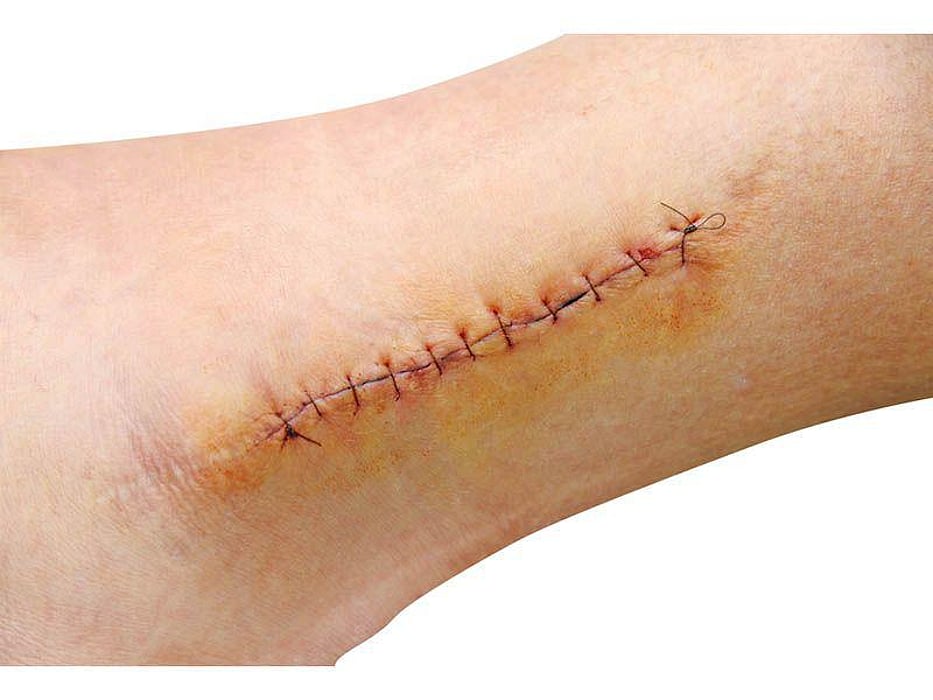Cuts and Stitches

As just about anyone who has chopped vegetables knows, minor cuts are a part of everyday life. Knowing how to care for them quickly can help prevent infection and lessen the chances of scarring. Before treating any cuts, remember to wash your hands thoroughly with soap and water to avoid contamination. Never cough, blow, or breathe on the wound. It's also important to know when a cut is serious enough to seek medical help.
What to do for minor cuts
If the cut is just skin-deep and there is minimal bleeding, begin by rinsing the wound with cold running water, if available. That should wash away any dirt, glass, or other foreign material that may be in the wound. If water isn't enough to get rid of the particles, dip a pair of tweezers into rubbing alcohol and carefully remove them. Then, if the wound is bleeding, apply pressure with a clean cloth or towel and raise the wound above your heart. If the edges of the wound can be brought together, cover with a butterfly bandage. If not, it is important to seek medical care immediately, so the cut can be stitched.
Note: Superficial cuts to the scalp may bleed more heavily because the blood vessels in the scalp are close to the surface. Cover the wound with a sterile dressing and apply pressure to stop the bleeding. If the bleeding does not stop after 10 minutes, seek medical assistance immediately.
What to do for deep cuts
If a cut is deep and bleeding freely, it's important to stop the bleeding before cleaning the wound. Apply pressure using a bandage, clean cloth, or paper towel. If possible, raise the injured part of the body above the level of the heart to help reduce bleeding. When the bleeding stops, gently rinse the cut with cold running water. Rinse away any foreign material, such as dirt or glass. In some cases you may need to use sterile tweezers. Then gently clean the wound with soap and water.
Special warnings
If the cut continues to bleed after 10 minutes, call for medical assistance or go to an emergency room immediately. If the cut was caused by a rusty or dirty object, a tetanus booster may be in order. You will need a tetanus shot if you have never had one or if your last booster is more than 10 years old.
Do not remove foreign objects that are embedded in muscle or other tissue below the surface of the skin. Removal could cause the wound to bleed more seriously. Go to the nearest medical facility immediately.
You should not try to clean a major wound that extends deep into muscle or other tissue. Do not attempt to drive if your bleeding is so severe it soaks through bandages. Call 911 or find someone to drive you to an emergency medical facility immediately.
Cuts that require stitches
Gaping cuts with jagged edges typically require stitches. Cuts on the face, eyelids, lips, palms, or fingers may require stitches even when the gash seems small. The skin on these parts of the body is so taut that it is difficult for it to mesh together and heal on its own. If you suspect that a cut may need stitches, call your doctor's office for advice or go to a medical facility. To avoid the risk of serious infection and help prevent or lessen scarring, a deep cut should ideally be sutured within 6 to 8 hours, and at maximum, within 24 hours after the injury. If you wait any longer, the stitches you get may not hold and the risk of infection is greater.
When to seek medical help
Seek medical help immediately if any of the following conditions exist:
- A cut bleeds in spurts, soaks through bandages, or doesn't stop bleeding after 10 minutes of firm, direct pressure.
- The cut is deep or jagged and may require stitches to heal.
- The injury was caused by a dirty or rusty object, especially if you have not had a recent tetanus vaccination.
- Foreign material is embedded in the cut and can't be removed.
- The wound shows signs of infection, such as redness, swelling, or numbness or it is oozing fluid.
- Red streaks form near the wound.
- The victim has a puncture wound or deep cut and hasn't had a tetanus shot in the last 5 years.
- The victim runs a temperature over 100 degrees F.
References
Handbook of First Aid and Emergency Care. American Medical Association.
American College of Emergency Physicians. First Aid Manual.
The American Red Cross First Aid & Safety Handbook.
Cuts and Puncture Wounds. Medline Plus Medical Encyclopedia. National Institutes of Health. http://www.nlm.nih.gov/medlineplus/ency/article/000043.htm
Cuts, Scrapes and Stitches: Caring for Wounds. American Academy of Family Physicians. http://familydoctor.org/041.xml
American Academy of Family Physicians. Cuts, Scrapes, and Stitches: Caring for Wounds. http://familydoctor.org/online/famdocen/home/healthy/firstaid/after-injury/041.html
Related Posts
CDC: los pacientes que visitaron unas clínicas quirúrgicas en México están en peligro de meningitis
JUEVES, 8 de junio de 2023 (HealthDay News) -- Las autoridades de salud de EE....
In Good News for U.S., Flu Vaccine Working Well in South America
MONDAY, Sept. 11, 2023 (HealthDay News) – In a finding that should ease the...
Flesh-Eating Bacteria Cases Spike in Florida County After Hurricane Ian
TUESDAY, Oct. 18, 2022 (HealthDay News) – Florida residents dealing with the...
